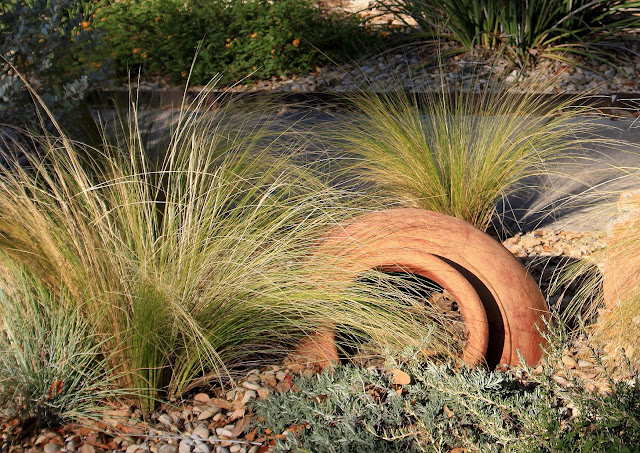There's only a little work to do in the front garden this year and that's by design.
We planned for low maintenance and the same look year round. Yes, that's a lot of concrete!
Out at the end of the driveway, three beautiful Yucca 'Color Guard' plants died after blooming last spring and Agave lophantha 'Splendida' offsets were planted as a quick (free) replacement.
The agaves are the green, spiky plants behind dormant Salvia greggii.
I miss the bright yellow accent provided by the yuccas. Instead of more short-lived yuccas, I'll plant Agave shidigera 'Shira itoh no ohi'. A cold hardy, full sun plant that rarely offsets and promises to stay put for 10-25 years is just what I'm looking for here. I have one, just need to find two more.
Freshly mulched driveway bed all ready for spring. Ruby Crystals (Melinus nerviglumis) grass replaced Mexican Feather Grass (Nasella tenuissima) at the base of the Silverado Texas Sage last fall. Mexican Feather Grass spends too much time in a brown, dormant stage for me. Ruby Crystals has stayed green so far this winter and is even blooming in spots. A prolific reseeder, Ruby Crystals should spread quickly to soften driveway edges and it requires very little water to look good year round.
Pennisetum grasses with seedheads provide winter interest in the driveway island. These were entirely free of charge since the seeds blew down from my neighbor's garden several years ago and I've been transplanting seedlings ever since. A Vitex at the corner of the garage will be removed this year. Pruned into tree form by the original owners, it looked great for about 20 years. Blooms and leaves have been sparse the last few years so it's time for it to go. As for a replacement, I'm currently shopping for a tall Yucca Rostrata that hopefully doesn't require a second mortgage!
Here's a corner that definitely needs work. I replaced underperforming Spanish Lavender with those three grass-like Flax Lillies (Dianella 'Baby Blue') last fall. When I couldn't find enough matching plants, I added Dyckia 'Silver Nickel' in the triangle end. But it was too wet for Dyckia (that sad grey plant on the right) so what's left will be potted up and, if I can't find more of the same Dianella variety, the original three will be divided. They'll be small but at least I know they work well here.
Love the blue-green color of this variety of Dianella or Flax Lily which will eventually produce small blue flowers.
A small agave bed along the front walk is coming along. Copying a popular idea I've seen on garden tours in Austin, my plan is for small agaves nesting within silvery ground cover. After losing the first planting of Wooly Stemodia groundcover to torrential downpours last spring, we've reworked the soil to try again with better drainage.
So far, so good with the new plants surviving late fall torrential rains. Wooly Stemodia is the best choice for the look I want since deer avoid it while devouring similar options. It still looks sparse so I'll add a few more to get the gravel mulch covered faster.
The bistro set looks a little lonely without its usual topping of potted plants.
Most are cold hardy but I've moved them to the porch just in case. They'll be moved back out soon.
Duranta 'Gold Mound' usually dies back so I'm enjoying its bright color during this warm winter. Not much to do here since last fall I added a few variegated Liriope to fill in along rock edging.
Now looking through the gate, evergreen Rosemary provides spots of deep green in the circle garden.
We expanded the crevice garden last fall for more places to plant sun-loving cacti and succulents on a slope where nothing else would grow. As some of my favorite plants offset, I'll add them here.
Perennials await cutting back in early March. I usually wait until then in order to protect new growth from late freezes and provide winter cover for birds and insects. We've even got a few blooms on Henry Deulberg salvia.
Over the south fence, I see more work to do! The dry creek needs clearing out and sedges along the walk should be divided. Still I am reminded this area has come a long way over the last couple years.
Duranta 'Sapphire Showers' has grown massive and will either be transplanted or removed so the entire bed can be reworked. I love the delicate blue flowers but it's not a spectacular plant in any other sense especially when it overwhelms the narrow space.
Now I have my work planned, I just need to get it all done!



















.jpg)











